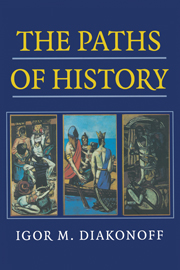Book contents
- Frontmatter
- Contents
- Foreword by Geoffrey Hoskins
- Preface
- Introduction
- 1 First Phase (Primitive)
- 2 Second Phase (Primitive Communal)
- 3 Third Phase (Early Antiquity)
- 4 Fourth Phase (Imperial Antiquity)
- 5 Fifth Phase (the Middle Ages)
- 6 Sixth Phase (the Stable Absolutist Post-Medieval Phase)
- 7 Seventh Phase (Capitalist)
- 8 Eighth Phase (Post-Capitalist)
- Index
7 - Seventh Phase (Capitalist)
Published online by Cambridge University Press: 02 December 2009
- Frontmatter
- Contents
- Foreword by Geoffrey Hoskins
- Preface
- Introduction
- 1 First Phase (Primitive)
- 2 Second Phase (Primitive Communal)
- 3 Third Phase (Early Antiquity)
- 4 Fourth Phase (Imperial Antiquity)
- 5 Fifth Phase (the Middle Ages)
- 6 Sixth Phase (the Stable Absolutist Post-Medieval Phase)
- 7 Seventh Phase (Capitalist)
- 8 Eighth Phase (Post-Capitalist)
- Index
Summary
The diagnostic features of the Seventh Phase are as follows: transformation of the natural sciences into a productive force (invention of the steam engine, the railway, the steamship, later the internal combustion engine, electric light, the telegraph, the telephone, etc.; introduction of science into industrial production and agriculture); rapid growth of armaments throughout the period (improved rifle firearms, smokeless powder, long-range artillery, ironclad battleships, at first powered by steam and later by diesel; the invention of the aeroplane, the tank, chemical warfare); the juxtaposition of the bourgeoisie and the hired workers as the two main social classes; the coming into being of an intelligentsia; a tendency (although as yet not strongly felt) towards disintegration of the peasantry into the same two classes of entrepreneurs and hired workers; preservation, on the periphery of the society, of the former classes of the Sixth Phase; the growing importance of non-religious ideologies, both those accepting and vindicating the existing development of the historical progress (such as positivism), and those already alternative to them (such as Marxism); these ideologies grew and were strengthened at the same time as traditional religions were growing weaker; however, the latter did retain, in different degrees, their official status, and to a certain degree they were still determining factors in the formation of national character; creation of republican states, or of monarchies with the monarch's powers very limited by constitution; a complete parcelling, between the capitalist colonial powers, of the regions which had not yet reached the Seventh Phase; armed rivalry between the societies that had reached it; creation of colonial empires, or a struggle for their institution; wars on a vast scale with enormous destruction and loss of life.
- Type
- Chapter
- Information
- The Paths of History , pp. 193 - 323Publisher: Cambridge University PressPrint publication year: 1999



